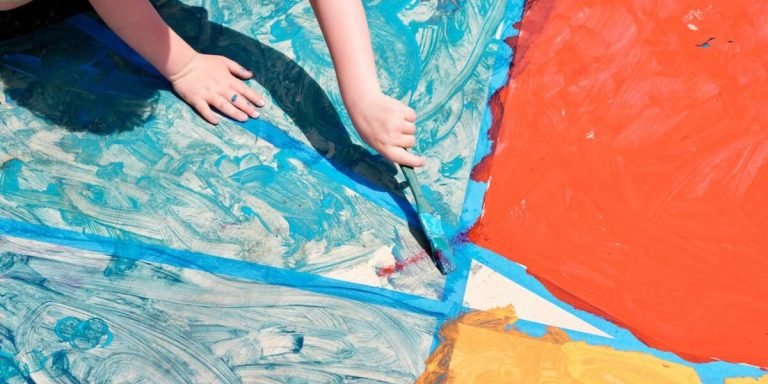Fun Activities for Kindergarten: Promoting Learning and Engagement
Dropping off children for their first day of kindergarten can be an emotional roller coaster. As parents, you strive to make this transition as smooth and enjoyable as possible for them. In this regard, integrating “fun activities for kindergarten” into the curriculum is a proven strategy that makes learning fun while also helping in overall development.
This blog addresses Activity Based Learning (ABL), considered one of the most effective pedagogical methods today. ABL goes beyond traditional teaching practices – it engages young minds through interactive sessions where they learn by doing themselves. These firsthand experiences not only instill critical thinking but also foster creativity among kindergartners.
Did you know?
In a study by the University of Virginia, it was revealed that kindergarten teachers spend approximately 80% of their day on basic literacy and math activities. Thus highlighting the importance & potential impact fun learning activities can have in adding more balance to this percentage.
Embracing Activity Based Learning in Kindergarten
Embracing activity-based learning in kindergarten is a dynamic progress towards an interactive educational setting. As the world continues to evolve with advancing technology, it’s essential for our teaching methods to keep pace and adapt accordingly. Kindergarten classrooms of 2023 are no longer confined within four walls but have expanded their horizons seeking help from current technologies.
Activity based learning packed with fun activities keeps the young minds engaged while stimulating creativity and critical thinking abilities. With new digital tools at disposal such as virtual field trips, online puzzles, e-books etc., teachers can make sure that every student actively participates in class rather than being passive listeners. This approach allows children to learn by doing — this hands-on method elicits excitement about education among kindergarteners making lessons memorable.
Kindergarten educators now realize how today’s tech-savvy generation responds positively when they integrate technology into traditional pedagogical strategies like activity-based learning (ABL). ABL not only breaks away from rote memorization but also strengthens concept understanding through application; hence fostering problem-solving skills right from early childhood days which are crucial for future success.
Key Elements of Engaging Activity-Based Lessons
The key elements of engaging activity-based lessons are instrumental in making learning fun, lively and memorable for kindergarten kids. The incorporation of such activities is a progressive shift from traditional teaching methods that focused on rote memorization to more interactive and hands-on experiences.
One crucial element is the incorporation of technology into these activities. With advancements happening every day even as we speak here in 2023, it’s essential to harness this power for educational purposes. Simple tech tools like tablets can be filled with educational games or creative programs enabling children to learn while they play.
Crafting kid-friendly problem-solving scenarios forms another vital constituent in creating effective activity-based lessons. Introducing problems through stories hooks young minds better than merely presenting mathematical equations would do.
However, remember not all “fun activities for kindergarten” need high tech tools; sometimes low-tech resources work wonders too! Building blocks help teach little ones about shapes and structures – an early introduction to geometry concepts!
Working together fosters teamwork among learners—it’s a paramount feature present across various types of active learning paradigms—be it solving puzzles collectively or taking part in group reading sessions.
Ultimately ensuring flexibility stands central amongst key ingredients- adapting according to individual learner patterns promotes inclusivity within classrooms which significantly adds value towards shaping their future education experience positively besides building confidence early on at such tender age stages itself!
In conclusion, embracing Activity Based Learning entails incorporating both technological integration alongside simple classic strategies thereby transforming conventional schooling ideologies whilst potentially unlocking unlimited potential possibilities inherent within each child.
Integrating Play with Educational Outcomes
In the modern education system, integrating play with educational outcomes has taken center stage. It’s a concept that merges learning and fun into an inseparable duo.
When we talk about kindergarten education in 2023, activity-based learning is no longer just trendy rhetoric; it’s now at the core of effective early childhood teaching strategies. Using fun activites for kindergarten not only sparks engagement but also accelerates comprehension and retention of knowledge among young learners.
One clear solution lies in technology—yes you heard right! The idea isn’t to let them lose themselves in video games or frivolous online activities—it’s to promote meaningful tech-driven learning experiences.
For instance, interactive digital storybooks are fantastic tools that can be seamlessly incorporated into everyday classroom routine. They bring stories alive with vivid animations and playful sound effects which skyrocket children’s interests levels tenfold!
Virtual reality (VR) serves as another example. Don’t jump to conclusions; these products aren’t the complex gear adults use. Instead, they’re user-friendly and designed specifically for children. Kids get guided through incredibly realistic environments—imagine exploring vibrant undersea corals one moment and roaming the scorching Sahara desert the next—all from their classroom desks! This immersive ‘potential field trip’ brilliantly combines whimsical adventure-filled playtime with tangible academic results.
Strategies for Implementing Fun Activities in Classrooms
In the context of early childhood education, it’s important to recognize that ‘fun’ and ‘learning’ are not mutually exclusive. In fact, integrating fun activities into the kindergarten curriculum can be a significant driver for enhancing student engagement and educational outcomes. One prominent strategy that represents this concept is technology integration in classrooms.
When we talk about Technology Integration in Education in 2023, one cannot help but mention modern tools like interactive whiteboards, tablets with child-friendly applications or even virtual reality devices specially designed for learning purposes; these have all opened up new realms of possibilities. Kindergarteners today aren’t just finger painting or molding clay – they’re also exploring digital landscapes which foster creativity while reinforcing fundamental concepts.
At its core, Activity-Based Learning (ABL) encourages children to learn by doing rather than merely memorizing textbook information. ABL merges physical activity with cognitive tasks to engage children mentally and physically throughout their school day.
Practices like creating digital artwork on touchscreen devices or tackling basic coding challenges with kid-friendly software develop critical thinking skills in kindergarteners. They also maintain student interest, making them eager for each new day at school.
Designing Interactive Games That Promote Learning
Designing interactive games that promote learning is instrumental in shaping the educational experiences of children. When used strategically, these fun activities for kindergarten can ignite curiosity, foster creative thinking and establish an enjoyable atmosphere conducive to learning.
Let’s delve into some ideas on how you can embed technology integration in education through activity-based learning.
1. Coding Games: Expose your young learners to coding with beginner-friendly software such as Scratch Jr. It allows students to create their own stories or games using easy drag-and-drop coding blocks, effectively enhancing their logical reasoning capabilities along with nurturing problem-solving skills.
2. Virtual Field Trips: Not all classrooms have four walls! Use virtual field trips apps like Google Expeditions or NearPod VR where kids can explore sites from around the world right from their classroom seats.
This not only expands geographical awareness but also complements specific lesson plans impeccably linking screen time with active knowledge acquisition.
3. Interactive Storytelling Apps: Allow tales come alive by utilizing storytelling apps such as Little Stories Producers which encourages creativity while consolidating language arts concepts amidst gales of laughter and suspenseful gasps!
4.Flat Teacher Adventures- One ingenious way of connecting beyond school premises could be sending flat teacher tokens home or even around the globe alongside pupils during vacations! Schools could leverage social media platforms for sharing pictures whilst integrating geography, cultural understanding and family involvement within this exciting escapade!
Utilizing Storytelling as a Dynamic Teaching Tool
Storytelling has long been a fundamental means of communication and learning. In recent years, however, educators have begun integrating this timeless practice into their teaching methodologies more strategically – making it one of the most impactful fun activities for kindergarten students.
Weaving tales in classrooms not only sparks curiosity but also enhances cognitive skills among young learners. When conveyed visually or interactively via digital platforms, stories can bring even complex concepts to life in an engaging manner that aligns perfectly with technology integration in education as we see it today.
One way is through writing software programs available online where children can create imaginary characters and scenarios using tools like animation and graphic design. These interactive storytelling sessions provide hands-on experiences encouraging creativity while fostering critical thinking skills through problem-solving aspects inherent within story creation processes.
Another approach is leveraging augmented reality (AR) apps designed specifically for educational purposes such as Google Expeditions or AR Flashcards . Using these tools allows teachers to transport students onto an adventurous journey right from their classroom seats! Students become active participants by interacting directly with virtual elements thus creating tangible connections between theoretical knowledge gleaned from textbooks and authentic world experiences rendered via AR technologies.
Assessing the Impact of Active Learning on Early Childhood Development
In a rapidly modernizing world, technology integration has become an integral part of effective education. Early childhood development requires robust learning strategies that not only impart knowledge but also stimulate mental models and reasoning abilities. To this end, ‘activity-based’ or ‘active learning’, especially in kindergarten settings are showing promising results.
Activity-based learning offers fun activities for kindergarteners enhancing their engagement levels with practical concepts introduced through interactive technologies. Innovative teaching tools like virtual reality devices, artificial intelligence-powered bots and mobile apps have been harnessed to provide immersive experiences capable of nurturing young minds more effectively than traditional methods alone can achieve.
Moreover, active participation in these technological-powered fun activities holds the potential benefit of developing problem-solving aptitude, critical thinking skills as well as honing creativity amongst youngsters at an age when cognitive flexibility is highest. The impact it creates on early childhood development cannot be overemphasized enough – redefining academic milestones while setting new standards for 21st-century skill development.
Real-time assessments help educators identify individual strengths and areas needing improvement among children during these formative years—an indispensable tool offered by tech-integrated activity-based instruction which goes beyond bookish knowledge towards holistic growth.
Monitoring Progress Through Observational Techniques
As we navigate our way through 2023, these observational methods not only continue to gain prominence but also see considerable evolution driven by advancements in tech tools.
One key aspect is activity-based learning. This practical approach keeps young minds engaged while offering them an opportunity to enhance their understanding of complex concepts organically.
Through interactive games or innovative apps available on tablets or computers, kindergarteners can enjoy matching shapes, solving puzzles or even coding simple programs under guided supervision. These digital platforms provide instant feedback about a child’s performance and enable educators and parents to track growth over time.
For instance, tracking the screen-time spent by each student contributing towards productive educational engagement helps monitor overall participation rates among different recreational tasks assigned during class hours. It provides insights into which fun activities fascinate kids more than others thereby helping teachers strategize better lesson plans.
Moreover, with increasing emphasis on fostering self-learning abilities among youngsters at this impressionable age where they are most receptive to new ideas—it encourages independence too! Children learn decision-making skills like choosing what game they want play next—which further fuel critical thinking capabilities from an early stage.
Also noteworthy is how using such technological solutions allows educators assess individual strengths weaknesses without causing any undue stress related conventional tests exams because evaluation here done subtly effortlessly compared traditional approaches—the real magic lies subtlety!
Encouraging Self-Assessment and Peer Feedback Among Kindergarteners
Self-assessment and peer feedback are important tools in the educational journey of kindergarteners. Integrating these elements with fun activities for kindergarten can have significant impacts on early childhood development, especially when combined with technology integration.
Kindergarten is a critical stage where children begin to understand their strengths and weaknesses. When educators incorporate self-assessment practices into activity-based learning, it encourages students to be more aware of their own progress. For instance, using an interactive online tool that allows them to track their skill acquisition process could effectively engage kids.
Peer feedback is another useful method underpinning modern education techniques applied within this age group context. This strategy can help young learners gain confidence while enhancing communication skills by sharing thoughts about each other’s performance openly but constructively.
Online collaborative platforms or digital storytelling apps present innovative ways through which our youngsters not only learn from one another but also develop essential life skills such as empathy and understanding towards peers’ perspectives — all while being involved in enjoyable tasks or games related to curriculum content areas like maths, language arts etc., significantly fostering stronger connections between playtime experiences & academic achievements during this formative phase!
Conclusion
In a nutshell, integrating fun activities for kindergarten into your child’s learning journey can significantly boost their growth and engagement. By using these strategies, we not only foster creativity but also create an interactive setting that promotes cognitive development.
Your thirst to make the most of your little one’s educational experience doesn’t need to stop here! Feel free to explore our website where you’ll find countless resources aimed at boosting childhood education. From comprehensive guides designed specifically for parents or educators like yourself – navigating this path will be as enjoyable as it is fruitful with us by your side.







